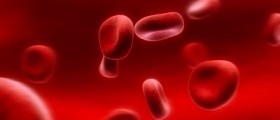
Leukemia is a type of cancer affecting white blood cells (leukocytes) characterized by an abnormal increase in number of these blood cells. This is not a single disease. Instead it represents a broad spectrum of illnesses all of which cause an increase in number of white blood cells of different developmental stage.
Classification of Leukemia
Leukemia can be classified into two major types known as acute and chronic leukemia.
In acute form of the disease there is a rapid increase in the number of immature white blood cells which does not allow the bone marrow to produce normal blood cells of other types. Treatment for acute leukemia must start at once and the goal is to prevent further uncontrollable progression of the disease and spread of these abnormal cells into other organs in the body. Acute leukemia is frequently reported among children.
Chronic leukemia is, on the other hand, a disease of relatively slow progression also characterized by abnormal white blood cells but these are relatively mature comparing to blood cells produced in case of acute form of the disease. Fortunately, patients suffering from chronic leukemia do not require treatment immediately but only when the number of abnormal cells becomes way too high. This type of leukemia is much more frequent among adults and especially older individuals.
Leukemia can be also classified according to type of white blood cells that are produced in abnormal amounts. For instance, in lymphoblastic leukemia, the abnormal cells are the one which would under normal circumstances fully develop into lymphocytes while myelogenous leukemia cancer cells are supposed to develop into red blood cells or other types of white cells or even platelets but this actually does not occur.
By combining previous two classifications we can finally become familiar with specific types of leukemia. A person may develop acute lymphoblastic leukemia (ALL), chronic lymphocytic leukemia (CLL), acute myelogenous leukemia (AML) and chronic myelogenous leukemia (CML). Hairy cell leukemia, T-cell prolymphocytic leukemia (T-PLL), large granular lymphocytic leukemia and adult T-cell leukemia are several more types of the disease which may occur.
Symptoms and Signs of Leukemia
The main characteristic of almost each and every type of leukemia is lack of mature blood cells of all three types of blood cells, leukocytes, erythrocytes and platelets. Namely, because the bone marrow becomes overcrowded with abnormal white blood cells of different immaturity, normal blood cells cannot develop to their full potential.
Because the body lacks platelets, patients' blood clotting process is damaged and most of them are prone to bruising, they bleed easily and excessively and their skin is covered in petechiae. Insufficient amount of mature white blood cells results in frequent and repeated infections, sores in the mouth, and plenty of opportunistic infections, those that does not affect people with normally functioning immune system. And finally, since the body does not have enough red blood cells, a person ends up with anemia.
Additional symptoms and signs of leukemia are fever and chills, extreme fatigue, hepatomegalia, splenomegalia and a variety of neurological symptoms and signs once the cancer cells spread to the central nervous system.
Causes
Even though many scientist are still trying to identify all the underlying causes of leukemia what needs to be said is that there is no single cause of this cancer and that different types can be triggered by different factors, either genetic or environmental.
This cancer, similarly to other cancers develops as a result of DNA mutations. Certain genes may mutate spontaneously or the process is triggered by radiation, exposure to carcinogenic substances etc. Benzene, alkylating chemotherapeutics, certain petrochemicals, hair dyes are all blamed for many cases of leukemia. Additionally, leukemia is associated with some viruses or occurs due to genetic predisposition.
Diagnosis
Complete blood count is sufficient enough for doctors to perceive an increase in the number of white blood cells. In order to confirm the diagnosis, patients undergo bone marrow biopsy and pathohistological examination of taken samples. Under certain circumstances even enlarged lymph nodes may be biopted.
Apart from confirming the presence of leukemia doctors additionally perform blood chemistry test to estimate potential damage to other organs such as the liver or kidneys and also recommends X-ray, MRI, ultrasound or CT scan of certain parts of the body which might have been infiltrated by cancer cells.
Relevant Data
According to data from the year 2000 leukemia affected around 256,000 people around the world and was blamed for lethal outcome of 209,000 of them. In 2008 in the United States approximately 44, 270 people were diagnosed this malignant disease , which made 2.9% of all malignant tumors at that time.
Acute lymphoblastic leukemia generally affects young children and elderly people while people older than 55 are commonly affected by chronic lymphocytic leukemia. Adults are also prone to acute myelogenous leukemia, especially men. The same refers to chronic myelogenous leukemia. T-cell prolymphocytic leukemia is considered one of the most aggressive types of leukemia. Fortunately, it does not occur that often.
















Your thoughts on this
Loading...